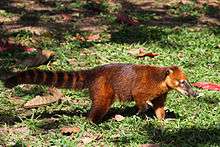South American coati
| South American coati[1] | |
|---|---|
 | |
| Scientific classification | |
| Kingdom: | Animalia |
| Phylum: | Chordata |
| Class: | Mammalia |
| Order: | Carnivora |
| Suborder: | Caniformia |
| Family: | Procyonidae |
| Genus: | Nasua |
| Species: | N. nasua |
| Binomial name | |
| Nasua nasua (Linnaeus, 1766) | |
| Subspecies | |
|
13, see text | |
 | |
| South American coati range. Note: Also found in west Ecuador, and west and north Colombia, see text. | |
The South American coati, or ring-tailed coati (Nasua nasua), is a species of coati from tropical and subtropical South America. In Brazilian Portuguese it is known as quati. Weight in this species is 2–7.2 kg (4.4–15.9 lb) and total length is 85–113 cm (33–44 in), half of that being its tail.[3] Its color is highly variable and the rings on the tail may be quite weak, but it lacks the largely white muzzle ("nose") of its northern cousin, the white-nosed coati.[3]
Distribution
The South American coati is widespread in tropical and subtropical South America. Most of its distribution is in the lowlands east of the Andes (locally, it occurs as high as 2,500 m or 8,200 ft), from Colombia and The Guianas south to Uruguay and northern Argentina (Chile is the only South American country where the species is not found).[2][3]
The status of coatis west of the Andes has caused some confusion,[4] but specimen records from west Ecuador, and north and west Colombia are South American coatis.[5][6] The only documented records of white-nosed coatis in South America are from far northwestern Colombia (Gulf of Urabá region, near Colombian border with Panama).[5][6] The smaller mountain coatis are mainly found at altitudes above the South American coati, but there is considerable overlap.[7]
Behavior

South American coatis are diurnal animals, and they live both on the ground and in trees.[8] They typically live in the forest.[9] They are omnivorous and primarily eat fruit, invertebrates, other small animals and bird eggs.[8] Coatis search for fruit in trees high in the canopy, and use their snouts to poke through crevices to find animal prey on the ground.[8] They also search for animal prey by turning over rocks on the ground or ripping open logs with their claws.[8]
Females typically live in large groups, called bands, consisting of 15 to 30 animals.[8][9] Males, on the other hand, are usually solitary.[9] Solitary males were originally considered a separate species due to the different social habits and were called "coatimundis",[9] a term still sometimes used today. Neither bands of females nor solitary males defend a unique territory, and territories therefore overlap.[9]
Group members produce soft whining sounds, but alarm calls are different, consisting of loud woofs and clicks.[8] When an alarm call is sounded, the coatis typically climb trees, and then drop down to the ground and disperse.[8] Coatis typically sleep in the trees.[8] Predators of the South American coati include foxes, jaguars, jaguarundis, domestic dogs, and people.[10]
Reproduction
All females in a group come into heat simultaneously when fruit is in season.[9] Females mate with multiple males.[9] Gestation period is 77 days.[9] Females give birth to 2–4 young at a time, which are raised in a nest in the trees for 4–6 weeks.[8][9] Females leave the group during this time.[8][9] Females tend to remain with the group they were born in but males generally disperse from their mothers' group after 3 years.[9]
Other
South American coatis generally live for up to 7 years in the wild, but can live up to 14 years in captivity.[9]
Subspecies
The South American coati has 13 recognized subspecies:[1]
- Nasua nasua nasua
- Nasua nasua aricana Vieira, 1945
- Nasua nasua boliviensis Cabrera, 1956
- Nasua nasua candace Thomas, 1912
- Nasua nasua cinerascens Lönnberg, 1921
- Nasua nasua dorsalis Gray, 1866
- Nasua nasua manium Thomas, 1912
- Nasua nasua molaris Merriam, 1902
- Nasua nasua montana Tschundi, 1844
- Nasua nasua quichua Thomas, 1912
- Nasua nasua solitaria Schinz, 1823
- Nasua nasua spadicea Olfers, 1818
- Nasua nasua vittata Tschudi, 1844
References
| Wikispecies has information related to: Nasua nasua |
| Wikimedia Commons has media related to Nasua nasua. |
- 1 2 Wilson, D.E.; Reeder, D.M., eds. (2005). Mammal Species of the World: A Taxonomic and Geographic Reference (3rd ed.). Johns Hopkins University Press. ISBN 978-0-8018-8221-0. OCLC 62265494.
- 1 2 Duckworth, J.W. & Schipper, J. (2008). "Nasua nasua". IUCN Red List of Threatened Species. Version 2008. International Union for Conservation of Nature. Retrieved 9 October 2008.
- 1 2 3 4 Kays, R. (2009). South American Coati (Nasua nasua), pp. 526-528 in: Wilson, D. E., and R. A. Mittermeier, eds. (2009). Handbook of the Mammals of the World. Vol. 1, Carnivores. ISBN 978-84-96553-49-1
- ↑ Eisenberg, J., and K. H. Redford (1999). Mammals of the Neotropics: The Central Neotropics. Vol. 3, p. 288. ISBN 0-226-19541-4
- 1 2 Decker, D. M. (1991). Systematics Of The Coatis, Genus Nasua (Mammalia, Procyonidae). Proceedings of The Biological Society of Washington 104: 370-386
- 1 2 Guzman-Lenis, A. R. (2004). Preliminary Review of the Procyonidae in Colombia. Acta Biológica Colombiana 9(1): 69-76
- ↑ Helgen, K. M., R. Kays, L. E. Helgen, M. T. N. Tsuchiya-Jerep, C. M. Pinto, K. P. Koepfli, E. Eizirik, and J. E. Maldonado (2009). Taxonomic boundaries and geographic distributions revealed by an integrative systematic overview of the mountain coatis, Nasuella (Carnivora: Procyonidae). Small Carnivore Conservation 41: 65–74.
- 1 2 3 4 5 6 7 8 9 10 Emmons, Louise (1997). Neotropical Rainforest Mammals, A Field Guide (2nd ed.). pp. 153–154. ISBN 0-226-20721-8.
- 1 2 3 4 5 6 7 8 9 10 11 12 "BBC Ring-tailed Coati". Retrieved 2007-07-13.
- ↑ "Southern Coati". Retrieved 2007-07-13.
